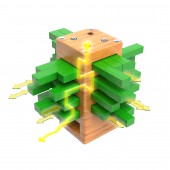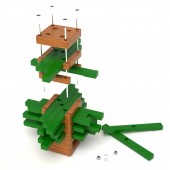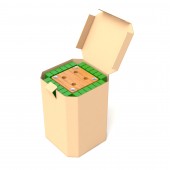
| THE AWARD |
| CATEGORIES |
| REGISTRATION |
| SUBMIT YOUR WORK |
| ENTRY INSTRUCTIONS |
| TERMS & CONDITIONS |
| PUBLICATIONS |
| DATES & FEES |
| METHODOLOGY |
| CONTACT |
| WINNERS |
| PRESS ROOM |
| GET INVOLVED |
| DESIGN PRIZE |
| DESIGN STORE |
| THE AWARD | JURY | CATEGORIES | REGISTRATION | PRESS | WINNERS | PUBLICATIONS | ENTRY INSTRUCTIONS |
Blindbox Wooden Game by Ufuk Bircan Ă–zkan |
Home > Winners > Design #32310 >Interview |
 |
|
FS: What is the main principle, idea and inspiration behind your design?
UĂ: Starting point for designing this game was to create a puzzle in a 3-dimensional structure with simple rules.
FS: What has been your main focus in designing this work? Especially what did you want to achieve?
UĂ: My aim was to create something that interact with our senses. BlindBox does not allow players to see what's happening inside. Instead it encourages to use our memory and hearing capabilities supported with touching and strategical thinking.
FS: What are your future plans for this award winning design?
UĂ: I want to develop it a bit more and market it as a production ready game worldwide.
FS: How long did it take you to design this particular concept?
UĂ: It was actually a school project of mine in Middle East Technical University, Department of Industrial Design. First version of the game was finished in November 2006. Later on in 2013, I revised the design and rules.
FS: Why did you design this particular concept? Was this design commissioned or did you decide to pursuit an inspiration?
UĂ: As a school project, our brief was just designing a wooden game. Then I come up with this idea as a final decision.
FS: Is your design being produced or used by another company, or do you plan to sell or lease the production rights or do you intent to produce your work yourself?
UĂ: I have applied for eligible copyrights, but it is not yet mass produced. I want to lease its property rights to a manufacturer.
FS: What made you design this particular type of work?
UĂ: I think people need to use their senses while having fun, like touching and feeling natural materials, instead of only using plastic buttons and LED displays.
FS: Where there any other designs and/or designers that helped the influence the design of your work?
UĂ: In the first sight it looks like a popular wooden block stacking/collapsing game. However, my first inspiration came from a game where you try to align 4 discs in a row to win.
FS: Who is the target customer for his design?
UĂ: As the game includes 10mm marbles made of glass and steel, it is not proper for children under 6. Anyone in any age over 6 and from any social level who will enjoy playing it are my target customers.
FS: What sets this design apart from other similar or resembling concepts?
UĂ: Although it does not allow players see the paths inside, it gives clues about where your marbles are and force you to use your memory and senses.
FS: How did you come up with the name for this design? What does it mean?
UĂ: BlindBox directly refers to a blind box, which you don't know what contains inside. BlindBox is a blind box for the game itself because in each session you have different maze paths and strategies.
FS: Which design tools did you use when you were working on this project?
UĂ: I started with sketches and then made a mock-up. When the product proved itself I prepared CAD data for presentation purposes.
FS: What is the most unique aspect of your design?
UĂ: It requires using senses to be successful in the game.
FS: Who did you collaborate with for this design? Did you work with people with technical / specialized skills?
UĂ: I was on my own while developing the game.
FS: What is the role of technology in this particular design?
UĂ: It does not require high technology. It can even be produced as an hand-made product.
FS: Is your design influenced by data or analytical research in any way? What kind of research did you conduct for making this design?
UĂ: I conducted market researches in order to define the needs in present games in the market.
FS: What are some of the challenges you faced during the design/realization of your concept?
UĂ: The hardest point was to achieve a bug-free game-play. Because games need rules, there shouldn't be any open point to manipulate the game out of its rules.
FS: How did you decide to submit your design to an international design competition?
UĂ: I explained the game to many of my friends and colleagues and everyone who listened were excited about it.
FS: What did you learn or how did you improve yourself during the designing of this work?
UĂ: I proved one more time what I had experienced before; that building mock-ups for products that require high physical interaction is vital.
FS: Thank you for providing us with this opportunity to interview you.
A' Design Award and Competitions grants rights to press members and bloggers to use parts of this interview. This interview is provided as it is; DesignPRWire and A' Design Award and Competitions cannot be held responsible for the answers given by participating designers.
| SOCIAL |
| + Add to Likes / Favorites | Send to My Email | Comment | View Press-Release | Translations |




